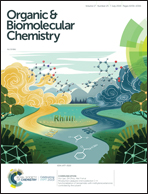The structure-based traceless specific fluorescence labeling of the smoothened receptor†
Abstract
The smoothened receptor (SMO) mediates the hedgehog (Hh) signaling pathway and plays a vital role in embryonic development and tumorigenesis. The visualization of SMO has the potential to provide new insights into its enigmatic mechanisms and associated disease pathogenesis. Based on recent progress in structural studies of SMO, we have designed and characterized a group of affinity probes to facilitate the turn-on fluorescence labeling of SMO at the ε-amine of K395. These chemical probes were derived from a potent SMO antagonist skeleton by the conjugation of a small non-fluorescent unit, O-nitrobenzoxadiazole (O-NBD). In this context, optimal probes were developed to be capable of efficiently and selectively lighting up SMO regardless of whether it is in micelles or in native membranes. More importantly, the resulting labeled SMO only bears a very small fluorophore and allows for the recovery of the unoccupied pocket by dissociation of the residual ligand module. These advantages should allow the probe to serve as a potential tool for monitoring SMO trafficking, understanding Hh activation mechanisms, and even the diagnosis of tumorigenesis in the future.

- This article is part of the themed collection: Chemical Biology in OBC


 Please wait while we load your content...
Please wait while we load your content...